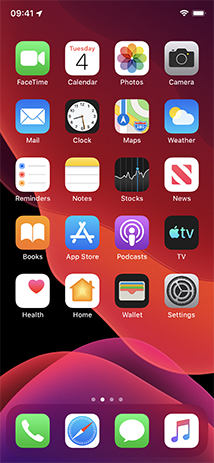- This page was last modified on 1 January 2026, at 00:04. Suggest an edit.
iOS 13 facts for kids
| Version of the iOS operating system | |
 |
|

iOS 13 home screen on an iPhone X
|
|
| Developer | Apple |
|---|---|
| Source model | Closed, with open-source components |
| Initial release | September 19, 2019 |
| Latest release | 13.7 (17H35) (September 1, 2020) |
| Repository |
|
| Update method | Software Update |
| Package manager | App Store |
| Platforms | iPhone, iPod Touch, HomePod |
| Kernel type | Hybrid (XNU) |
| Default user interface |
Cocoa Touch (multi-touch, GUI) |
| License | Proprietary software with open-source components |
| Preceded by | iOS 12 |
| Succeeded by | iOS 14 |
| Tagline | A whole new look. On a whole new level. |
| Support status | |
| Obsolete, unsupported. No longer receiving security updates, because all iPhones and iPod Touches that support iOS 13 also support iOS 14 and iOS 15. Drops support for the iPhone 5s and 6/6 Plus as well as the iPod Touch (6th generation). | |
| Articles in the series | |
| iPadOS 13 (iPadOS version derived from iOS 13) | |
iOS 13 was a big update for Apple's iOS mobile operating system. It was made for the iPhone, iPod Touch, and HomePod. This version came after iOS 12. Apple first showed iOS 13 at their Worldwide Developers Conference (WWDC) on June 3, 2019. It was officially released to everyone on September 19, 2019. Later, iOS 14 took its place on September 16, 2020.
With iOS 13, Apple made a special operating system just for iPads, called iPadOS. This meant that iPhones and iPads started to have different features. Both iOS 13 and iPadOS 13 stopped supporting older devices that had less than 2 GB of RAM.
Contents
- What's New in iOS 13?
- Keeping Your Information Private
- New Look and Feel
- Smarter Siri
- Typing Made Easier
- Easy Text Editing Gestures
- Sign In with Apple
- Better Performance
- Making Your Battery Last Longer
- Cool Vibrations (Haptics)
- Using External Storage
- ARKit 3 for Augmented Reality
- Gaming Controllers and Audio Sharing
- Easy Multi-Select Gesture
- App Updates
- Some Challenges
- Devices That Supported iOS 13
- Images for kids
- See also
What's New in iOS 13?
Apple's Senior Vice President of Software Engineering, Craig Federighi, introduced iOS 13 and iPadOS 13 at the WWDC event on June 3, 2019. After the announcement, developers could try out early versions. The first public test version was available on June 24, 2019. The final version, iOS 13.0, came out on September 19, 2019.
Keeping Your Information Private
iOS 13 brought important changes to how apps use your location. When an app wanted to know your location, you could choose to let it access your location only when you were using the app, never, or just one time. You would also get similar questions for apps that wanted to use your location in the background. This helped you control your privacy better.
New Look and Feel
Dark Mode for Your Screen
A cool new feature was the system-wide Dark Mode. This changed the look of your entire iPhone or iPod Touch screen to a dark theme. All of Apple's own apps and many other apps could use this dark look. You could turn it on whenever you wanted or set it to switch automatically, like at night.
Volume Control Redesign
The way the volume showed up on your screen also changed. Instead of a big box in the middle, it became a thinner bar. This bar appeared near the volume buttons when you held your phone upright. You could even touch and slide the bar directly to change the volume.
Smarter Siri
Siri got a new voice in iOS 13. It sounded more natural, almost like a real person talking. Siri also became more helpful. The Siri Shortcuts app was automatically installed, letting you create custom commands. Siri could also learn to recognize different voices on a HomePod. Plus, if you had AirPods, Siri could automatically read your incoming messages aloud.
Typing Made Easier
QuickPath Keyboard
The keyboard got a new feature called QuickPath. This let you type words by sliding your finger across the letters without lifting it. It made typing faster and easier.
Emoji Stickers
You could also find new emoji stickers on the emoji keyboard. These stickers could be used in messages and other apps, just like regular emojis.
Easy Text Editing Gestures
iOS 13 added new ways to cut, copy, paste, undo, and redo text using simple finger gestures.
- To undo something, you could swipe three fingers left or up.
- To redo, swipe three fingers right or down.
- A single three-finger pinch would copy text.
- A second three-finger pinch would cut text.
- Spreading three fingers apart would paste text.
- Tapping three fingers once would bring up a menu with all these options.
Moving the text cursor also became easier. You could press and hold the blue cursor to pick it up and drag it exactly where you wanted it. Selecting text got better too:
- Double-tapping a word selected it.
- Triple-tapping selected a whole sentence.
- Quadruple-tapping selected an entire paragraph.
Sign In with Apple
A new way to sign into apps and websites was introduced called "Sign in with Apple". This made it easier and more private to create accounts for different services. You could even choose to hide your real email address and have Apple create a special, temporary email address for you. This helped keep your personal information safer.
Better Performance
iOS 13 made your iPhone faster in several ways.
- Face ID unlocked your phone up to 30% quicker on newer iPhones.
- App downloads became smaller, up to 50% less data.
- App updates were also smaller, up to 60% less.
- Apps launched up to twice as fast.
Making Your Battery Last Longer
iOS 13 included a feature to help your battery stay healthy for longer. It could limit the battery charging to about 80%. This helps reduce stress on the lithium-ion battery and makes it last longer over time.
Cool Vibrations (Haptics)
A new system called Core Haptics was added. This allowed app developers to create custom vibration patterns and sounds. Before, apps could only use basic vibrations. Now, games and other apps could give you more detailed and fun feedback through vibrations. This feature worked on iPhone 8 and newer models.
Using External Storage
With iOS 13, you could finally connect external USB drives to your iPhone or iPod Touch and access files in the Files app. This meant you could easily move photos, videos, and documents to and from a USB stick or hard drive.
ARKit 3 for Augmented Reality
ARKit 3 was part of iOS 13 and brought new features for AR (Augmented Reality). AR lets you see digital objects mixed with the real world through your camera.
- People Occlusion made AR objects appear more realistically in front of or behind people.
- Other features included tracking multiple faces and working together on AR experiences.
These advanced AR features worked best on iPhones with A12 processors or newer, like the iPhone XS and iPhone XR.
Gaming Controllers and Audio Sharing
iOS 13 added official support for popular gaming controllers like the Sony DualShock 4 (PlayStation controller) and the Microsoft Xbox One controller. This made gaming on your iPhone or iPod Touch even better. You could also share audio wirelessly with friends using AirPods or certain Beats headphones.
Easy Multi-Select Gesture
A new gesture made selecting multiple items much faster. In apps like Files and Mail, you could drag two fingers over several items to select them all at once.
App Updates
Music App Lyrics
The Apple Music app now showed real-time lyrics that moved along with the song. The line being sung would be highlighted. You could also tap on a lyric to jump to that part of the song.
Messages and Memoji Fun
You could create your own user profiles in Messages and use a Memoji as your profile picture. All iPhones and iPod Touches with an A9 processor or newer could create custom Memoji. These Memoji and Animoji could be used as stickers in Messages and other apps, and even as regular emojis on the keyboard. There were many new ways to customize your Memoji.
Improved Maps App
The Maps app got a new design with more detailed maps. It also introduced Look Around, which let you see street-level views, similar to Google Street View.
Smarter Reminders App
The Reminders app was completely rebuilt. It could suggest when to remind you about something. You could also tag contacts in reminders, so the reminder would show up when you were talking to that person in Messages.
Better Photos App
The Photos app had a new look. It used smart technology to automatically hide "clutter" photos like screenshots or documents. The app also showed your photos in a new way, organizing them by year, month, week, and day. This helped you easily find and enjoy your favorite memories.
Some Challenges
After iOS 13 was released, some users experienced issues like battery draining faster, calls dropping, or ringtones not working correctly. Apple quickly released many updates to fix these problems.
Devices That Supported iOS 13
iOS 13 needed devices with at least 2 GB of RAM. This meant it no longer supported older iPhones and iPod Touches that had less memory or used older processors. iOS 13 was the first version to stop supporting iPhones with Touch ID.
Apple also decided to give iPads their own operating system, iPadOS, to make them more distinct from iPhones.
iPhone Models
- iPhone 6s and 6s Plus
- iPhone SE (1st generation)
- iPhone 7 and 7 Plus
- iPhone 8 and 8 Plus
- iPhone X
- iPhone XS and XS Max
- iPhone XR
- iPhone 11
- iPhone 11 Pro and 11 Pro Max
- iPhone SE (2nd generation)
iPod Touch Models
- iPod Touch (7th generation)
Images for kids
See also
 In Spanish: IOS 13 para niños
In Spanish: IOS 13 para niños
- iPadOS 13
- macOS Catalina
- tvOS 13
- watchOS 6


